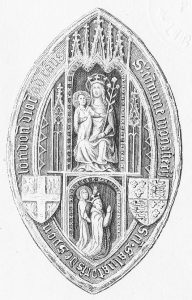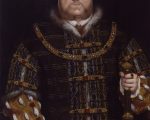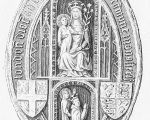
Engraving of original seal of the Abbess and Convent of Syon, Isleworth
On this day in history, 19th December 1576, Katherine Palmer, Abbess of Syon, died in Mechelen. Katherine and her nuns had fled from England to the Low Countries in 1559, following the accession of the Protestant queen, Elizabeth I, and had finally settled at Mechelen. There, on 8th November 1576, a mob of Calvinists broke into the monastery and the courageous abbess confronted them. It is thought that confronting the mob, a traumatic response, led to her death just over a month later, on 19th December. She was laid to rest at Mechelen in the Church of the Augustinians.
I dug a little into Katherine Palmer and her order. I found that she was of a gentry background and had given up that life to join the Bridgettine Order at Syon Monastery, in the parish of Isleworth, which had been founded by Henry V in 1415 and that had a reputation for its pious monastic life. Unfortunately, the abbey was dissolved in 1539 as part of the Dissolution of the Monasteries. However, the sisters kept their monastic life in small groups, one of which was led by Katherine.
In 1551, Katherine and six nuns and four brothers relocated to Termonde in the Low Countries. They returned to England in 1555, in the reign of the Catholic queen, Mary I, at Cardinal Pole's urging, and refounded Syon. Katherine was elected as abbess. As I said earlier, they fled England in 1559, moving to Termonde and then Antwerp and on to Mechelen, where Katherine died in 1576.
In his article for the Telegraph, Christopher Howse writes of how the order "went through astonishing sufferings from poverty and war, seeking refuge in France and Portugal" before finally settling back in England in 1861. In 1925, the order settled at South Brent, in Devon.
What is amazing is that they are the only surviving pre-Reformation religious community in England - wonderful!
Notes and Sources
- Ridgway, Claire (2012) On This Day in Tudor History, MadeGlobal Publishing.
- The survival of England's Syon, Christopher Howse, The Telegraph, 18 Oct 2008.




